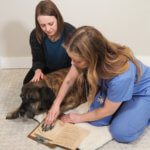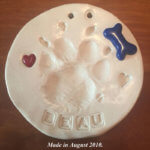A Bond-Centered Practice supports and responds to the emotional needs created by the human-animal bond. The practice of veterinary medicine is complex. Along with medical expertise, today’s veterinarians must also be well informed about legal issues, customer service techniques, personnel management, and successful business principles. The overall health and success of a practice is often defined by the results of this knowledge, which include animals’ lives saved, valuable staff retained, and annual profits gained. However, there is another significant measurement of professional achievement. That is, a practice’s ability to care for people, as well as animals. What is a Bond-Centered… Continue Reading
Blog
Avery’s Pawsitive Change
We were recently contacted by a very special girl named Avery (and her mother, Kim) about her mission, Avery’s Pawsitive Change. Avery is battling Ewing Sarcoma Cancer for the second time in less than a year. No one should ever have to battle cancer. And, no parent should ever have to watch their child go through it. However, as so many of us know, it is a sad reality that cancer is something that many people must face at some point in their lives either personally or because a loved one is diagnosed. Avery deserves all of the admiration in… Continue Reading
Dog Nose Print Mold
Did you know you can make a dog nose print mold using ClayPaws clay? ClayPaws clay is the premiere choice for making archival-quality paw prints of pets. However, it is not well known that this same trusted, proprietary clay formula can also be used to make beautiful nose prints. This blog will walk you through how to create a dog nose print mold for your clients and customers to get a truly striking result. This method can also be used for other pets, like cats. Simply adjust the amount of clay used to make the initial mold. Why Should I… Continue Reading
A Dog Paw Print That Lasts A Lifetime
The following post was sent out in our Veterinary Wisdom eNewsletter five years ago. Five years after saying goodbye to my childhood dog, Beau, I am still just as grateful to have a dog paw print of his. Since it is made from ClayPaws clay, I know it will last a lifetime: Earlier this month, my family said goodbye to our family dog, Beau. Mr. Beau Bear was the happiest dog I have ever met. As he got older, his eye-sight began failing, he couldn’t hear very well and he often seemed confused. But, he was always in a good… Continue Reading
Clay for Paw Print Making: Choose Oven-Bake
Choosing oven-bake clay for paw print making, specifically ClayPaws® Clay, means providing the highest-quality, longest-lasting paw print mementos for your clients! We want to remind you how positively this reflects on your clinic. They will always remember the compassionate, skilled support you offered them during their time of loss making them more likely to remain loyal to your clinic with the care of future pets. Considering using ClayPaws Kits, but not sure about baking? Well, baking is the strength of ClayPaws Prints! Pet parents tell us they keep their ClayPaws prints in a purse, their car, take them to work,… Continue Reading
High-Quality ClayPaws® Prints as an Act of Service
When you make a ClayPaws print for a family, you capture the love they shared with their pet and transform it into something permanent and tangible that they can hold on to forever. This is an act of service worthy of your time and the use of quality materials. By using archival-quality ClayPaws Clay to make paw prints, you honor the bond your clients had with their pets. This is a material you can be sure is up to the task. Once baked, a ClayPaws print is a permanent keepsake. Comparatively, most air-dry clays will eventually break down, curl, crack,… Continue Reading










